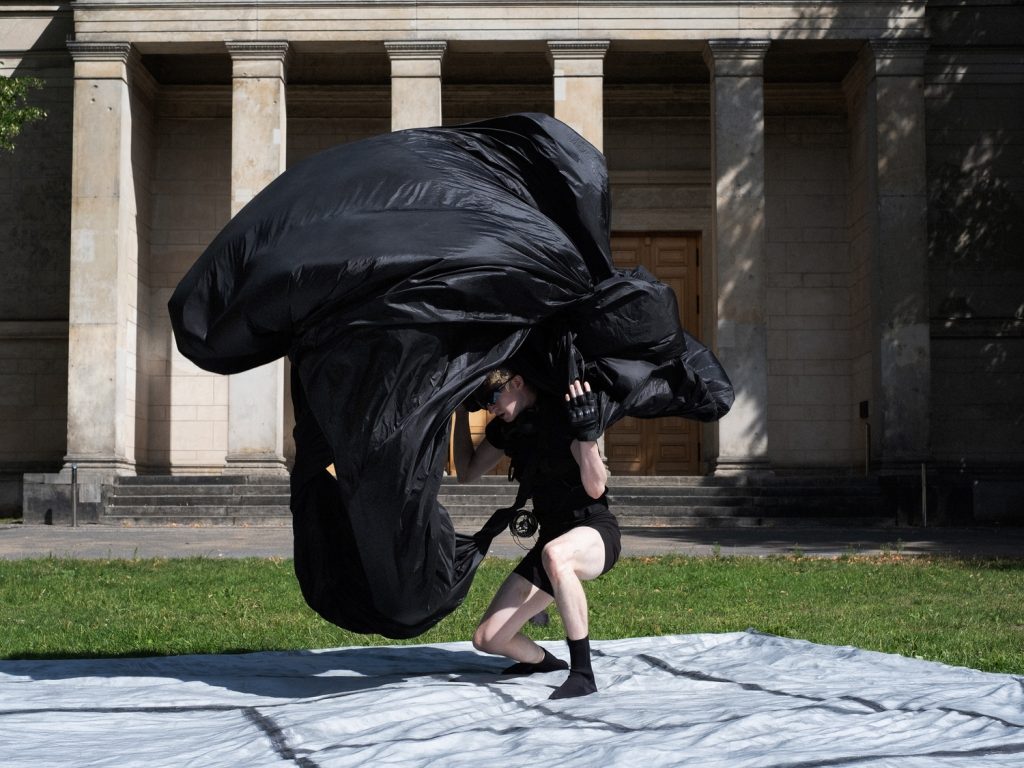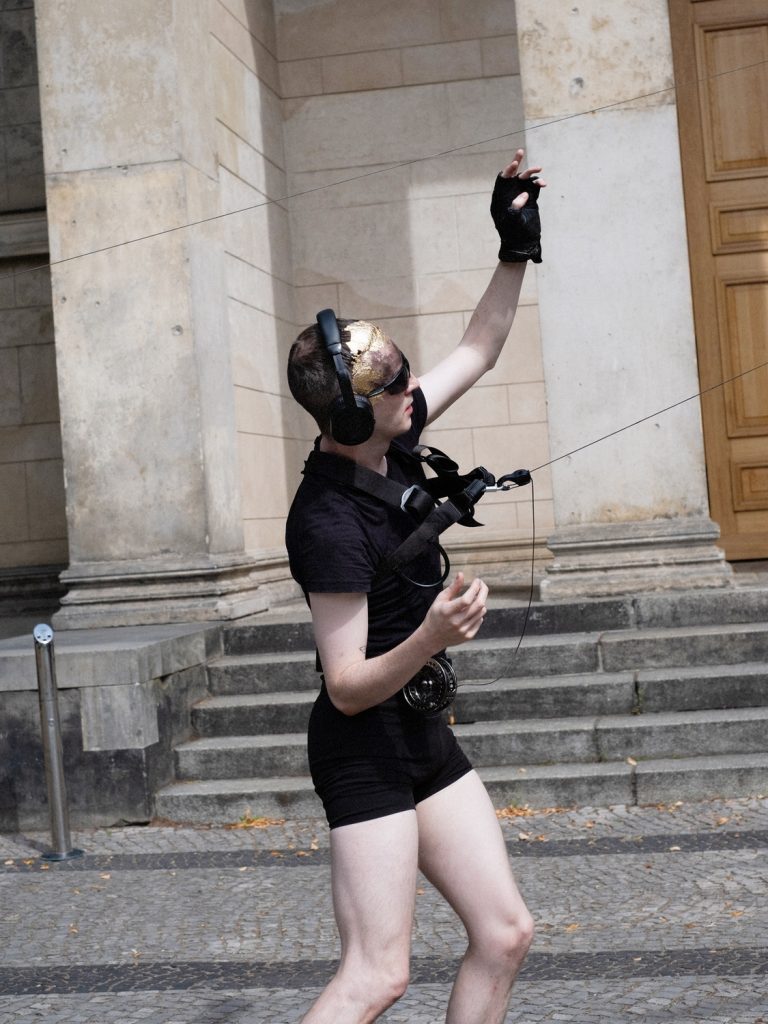12 August 2023
by Renae Shadler, in conversation with Ally Bisshop and Maikon K.
Photos: ‘Under my Gaze’ production images, Piotr Pietrus
‘Under my Gaze’ is a dance quartet performed by three people and an Aerocene sculpture. The project was presented at St. Elisabeth Church Park in Berlin in the summers of 2022 and 2023, and has an upcoming excerpt in the Tanz Im August – Interconnecting Dance & Ecology program later this month. It is the first part of a trilogy of works combining dance and the Aerocene, led by choreographer and dancer Renae Shadler whose research is centered around making more-than-human relations tangible in the context of performance art.
Renae Shadler, along with project dramaturgs Ally Bisshop and Maikon K, offers insight into their artistic process and exploration of solar energy’s impact on Earth’s ecosystem in a conversation at Volkspark Rehberge in Berlin while preparing for their performance.
Renae: Since my first Aerocene flight with the Susurrus group in 2018 (Samuel Hertz, Maria Nurmela, Kalle Ropponen and myself), I’ve been interested in the Aerorcene sculpture as an envelope that gives a physical form to the air, wind and sun that animate it.
We see the effects of these forces all the time – when a tree moves, when a big gust of wind knocks something over or when we get sunburned – but we cannot see the forces themselves. Aerocene gives a ‘body’ to these invisible entities that stir and surround us. For this reason, I wanted to create a trilogy with the sculpture, working with it as a collaborating dance partner for each unique creation.
Maikon: Indeed, understanding how the Aerocene interacts with atmospheric forces was one of the main starting points for the project. For Part 1 of the Trilogy, Renae decided to focus on solar energy, as reflected in the title.
Renae: Yes, the title ‘Under my Gaze’ alludes to the sun’s gaze, borrowed from Agnieszka Polska’s short film ‘The New Sun’ (2017), depicting the sun as a child-like witness to Earth’s development.
Ally: The ‘gaze’ is a metaphor for the direction of solar energy. The sun creates all these direct and indirect interconnections that define our actions and environments. It has shifted how organisms grow and shaped the ecologies that we live in.
Renae: When reflecting on my connection to the sun, its enormity and power often overwhelm me. I cannot begin to comprehend something of that magnitude. I began to see the Aerocene as an intermediary between the sun and humans, enabling us to experience the power of solar energy through the upward tug of the sculpture, as it heated the air inside and caused it to rise. This exploration led to the core questions in ‘Under my Gaze’: How to make a performance that acknowledges the sun as the driver of Earth’s ecosystem? And, how to collectively create a new poetics of movement that ‘moved with’ instead of ‘extracted from’ the atmosphere?
To achieve this, I was interested in the potential for the sun, wind, and air to guide our movements. For instance, wind direction significantly influences our choreography. If the wind is going northwest, we adjust our positioning to counteract it, adapting to achieve set spatial geometries on the ground.
Renae: The attempt to give the sculpture more agency led to set designer Camille Lacadee and costume designer Geraldine Arnold developing technology that enabled the sculptures to be strapped to the dancers bodies through the use of carabiners, reels, waist belts and chest harnesses. This strengthened the symbiotic relationship between the sculpture and the dancers, allowing the sculpture to steer us, forging a link between our solar plexus and the tethering point. The design created newfound freedom in movement as we were able to maintain the connection hands-free.


Ally: I want to speak to the sound design of the piece and return to the topic of ‘gaze’ for a moment. This solar perspective is present in the performance through a playful first-person narration from the sun’s viewpoint. The voice-over is a human voice imbued with an overseeing presence. It appears only at four moments in the piece, culminating in an original rock song composed by sound designer Samuel Hetz and artists.
Throughout the process, we contemplated what kind of gaze the sun has: Is it witnessing? Ambivalent? Does it harbor emotions for its surroundings? How do we characterize a gaze that is billions of years old?
“No one witnessed my birth. My birth was a catastrophe.
All languages have a name for me,
sing to me, dance with me,
look for me in a candle flame,
in a high resolution screen, in a falling horizon.“
– Except from ‘Under my Gaze’ headphone voiceover, 2022
Renae: Ironically, our shift away from a human-centric viewpoint towards the sun culminated in anthropomorphizing it through imaginative human intellect and voice. This choice, inspired by anthropologist Natasha Myers, aims to elevate nature to a ‘being worthy of address’ (Becoming Sensor, 2020). It allows the sun to transcend its role as a mere service ecosystem or exploitable resource and instead become an entity with which we coexist. While anthropomorphism risks oversimplifying the sun’s complexity, in ‘Under my Gaze’, it serves to render the sun more visible, accentuating its pivotal role.
Maikon: Our homage to the sun permeates the choreographic language, influenced by how other non-human entities harness solar energy. The group drew inspiration from various beings, including underwater hydra, which sense light with their tentacles, and phototrophic plants that grow directionally towards light. These references informed the dancers’ spiraling, outstretched movements.
Ally: Not only did we research entities that exist in the presence of the sun, but also those that shy away from it, such as nocturnal animals that thrive in dark spaces, like bats. For instance, Renae explored this in the ‘shadow duet’, where dancer Dorota Michalak moves only in the shadow of Aerocene, tracing its outline with limb and skin.
Renae: Certainly, much of the choreography arose from structured improvisations informed by our exploration of more-than-human responses to light and darkness, caused by Earth’s rotation relative to the sun. In addition, we worked with solar dynamics such as: gravitational pull, magnetic field and combustive power, which shaped our movement material.
Renae: Lastly, I would like to speak about the topic of ritual, which is especially present during the ‘eyes closed solo’ when I step into the inflated Aerocene sculpture and am enveloped by it, drawing a parallel to the sacrificial elements in ancient sun rituals.
Ally: There is definitely an emerging interest in how ecological studies and activist practices can think about ritual as a way of recalibrating a relationship to the environment, precisely because it asks us to stop and take care. Ritual in first-nation knowledge systems comes from deep and embedded relationships with place. I think rituals are useful because they are performative embodied storytelling practices that provide a pathway for thinking about our relation with things that aren’t rationally graspable.
Maikon: ‘Under my Gaze’ is a contemporary sun ritual where performers and the Aerocene thirst for the sun, drawing energy from its rays to fuel their movements. It embodies a symbiotic dance, and we will further explore its nuances throughout our project’s tour, as well as during the upcoming creation of Part 2 of the Trilogy entitled ‘Greyline.’
More information: http://renaeshadler.com/undermygaze
TEAM
Concept, Choreography, Performance: Renae Shadler | Performance: emeka ene, Dorota Michalak | Initial Performance: Mickey Mahar | Composition: Samuel Hertz | Set design: Camille Lacadee | Costume design: Geraldine Arnold | Dramaturgy: Ally Bisshop, Maikon K | Text: Maikon K, Renae Shadler | Production, Distribution: Dörte Wolter | Production assistant: Undine Sommers | Photos: Piotr Pietrus | Video: Camille Lacadee | Inspired by Susurrus group, 2017-2020: Samuel Hertz, Maria Nurmela, Kalle Ropponen, Renae Shadler
Presented by Renae Shadler & Collaborators in collaboration with Aerocene Foundation. Supported by Fonds Darstellende Künste with funds from the Federal Government Commissioner for Culture and Media within the program NEUSTART KULTUR.
